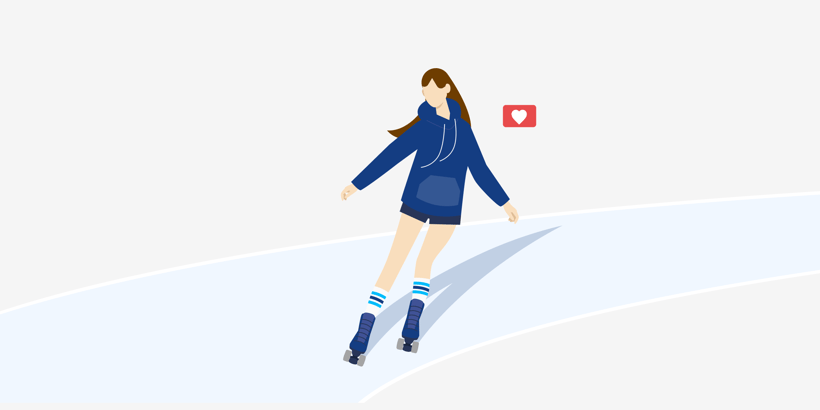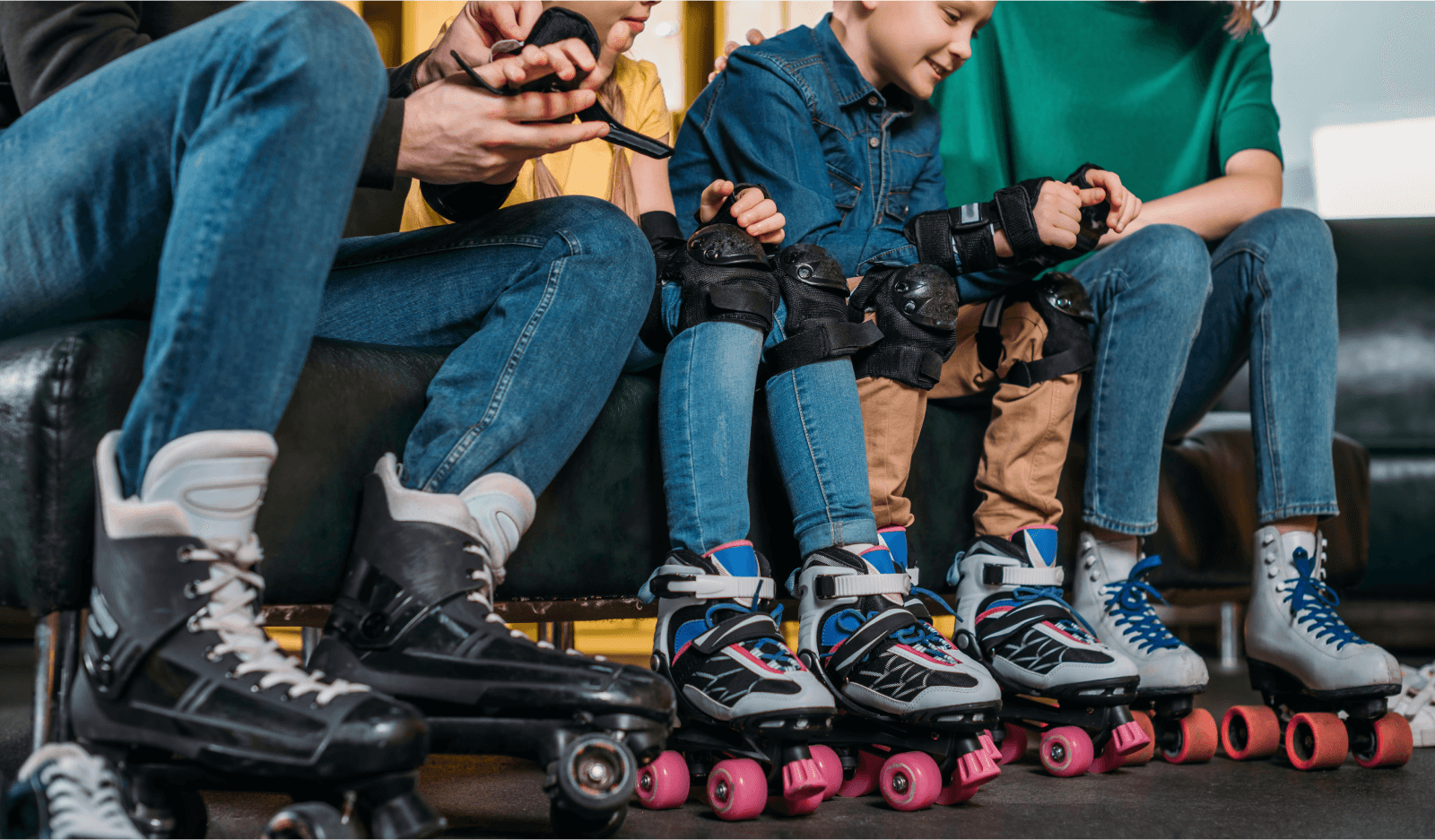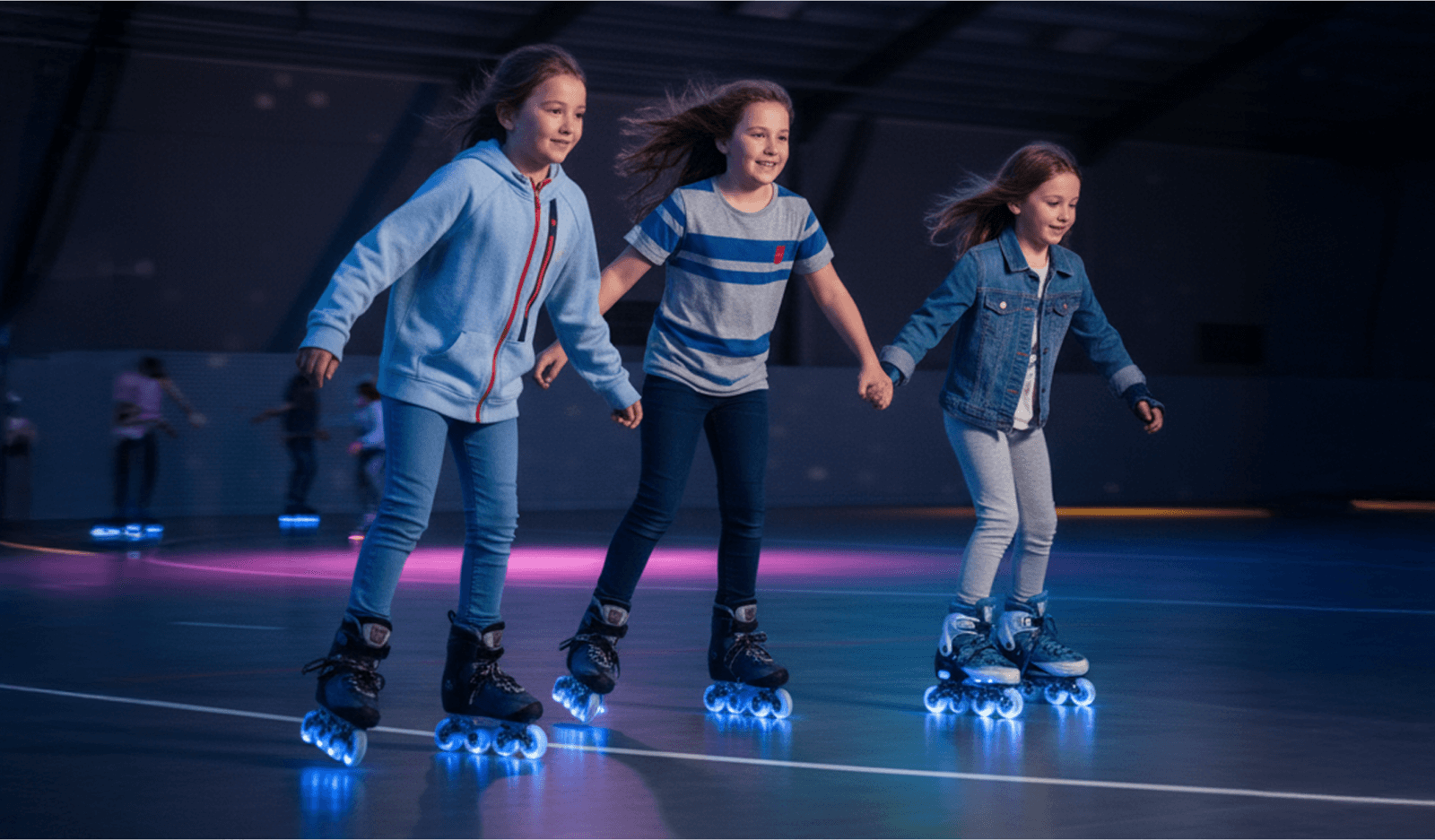How To Open a Roller Skating Rink: A Step-By-Step Guide for Entrepreneurs

Thinking about starting a roller rink? You're not alone. Roller skating is experiencing a powerful resurgence, fueled by nostalgia, fitness trends, and the universal appeal of good old-fashioned fun. Whether you're a lifelong skating enthusiast or a savvy entrepreneur looking to open a new entertainment venue, starting a roller skating rink can be an exciting and profitable venture.
But just like any business, opening a roller skating rink takes more than just lacing up your skates and flipping the lights on. From finding the right space and securing funding to writing a roller skating rink business plan and creating a great guest experience, there's a lot to consider.
This guide will walk you through everything you need to know about how to open a roller skating rink—from startup costs and business plans to operations and marketing. Let’s dive in.
Why open a roller skating rink?
Roller skating is back in the spotlight—and this time, it’s here to stay. With growing demand for active social entertainment and family-friendly venues, roller rinks are once again becoming hotspots for birthdays, weekend outings, and retro-themed events.
A booming opportunity for community and profit
The global roller skating market was valued at $4.8 billion in 2024 and is projected to grow to $7.9 billion by 2032, expanding at a steady rate of 6.2%.
The resurgence of roller rinks is driven by several factors:
- Fitness and wellness: Roller skating is increasingly seen as a fun, low-impact way to stay active, improve balance, and boost cardiovascular health.
- Social media culture: Platforms like TikTok and Instagram have revived roller skating as a fashion-forward, expressive pastime, attracting younger skaters with viral content and aesthetic appeal.
- Customization and self-expression: Consumers are seeking personalized skates with unique colors, accessories, and styles, contributing to a vibrant roller culture and strong demand for themed events and custom gear.
- Family-friendly appeal: Rinks offer screen-free fun for all ages—making them a top choice for birthday parties, youth programs, and weekend outings.
- Post-COVID resurgence: After temporary declines during pandemic restrictions, the industry has bounced back with renewed interest in both indoor and outdoor skating activities, helped by accelerated growth in e-commerce and at-home skate sales.
In other words, roller skating isn’t just back—it’s evolving. With skates now viewed as both fitness equipment and lifestyle accessories, and rinks doubling as social spaces and entertainment venues, the market is primed for long-term growth.
How much does it cost to open a roller skating rink?
Opening a roller skating rink requires a significant financial investment, with total startup costs typically ranging between $500,000 to $1.5 million. The overall cost depends on several factors, including facility size, location, equipment, and technology.
Costs include:
- Leasing or purchasing a property
- Rink floor installation
- Renovations and build-out expenses, such as installing flooring, lighting, HVAC systems, and fire safety measures
- Zoning permits and licenses
- Equipment and skates
- Technology and software
- Marketing and branding
- Staff hiring and training
How to open a roller skating rink business: step-by-step guide
1. Write a roller skating rink business plan
Every successful venue starts with a clear, detailed business plan. A strong roller skating rink business plan will help you secure funding, estimate costs, and guide your decisions from day one. Investors and lenders want to see how your business will operate, grow, and turn a profit over time.
Whether you're starting from scratch or revitalizing an existing venue, your plan should showcase your vision, market fit, and financial roadmap. The more detailed and realistic your plan is, the easier it will be to gain support and build long-term success.
Roller skating rink business plan template
Here’s a simple structure you can follow when writing your plan:
- Executive summary: Provide a snapshot of your business, including the venue name, mission, location, target market, and high-level financial goals.
- Business overview: Describe the type of experience you’re offering and the unique value your roller rink will bring to the market. Will your venue focus on retro-themed fun with disco nights and classic hits? Or are you aiming for a sleek, modern space for all-ages family outings? You might also target specific niches like fitness skating, roller dance, or teen-focused social events. Define your positioning clearly to set the tone for the rest of the plan.
- Mission statement and business goals: Share your core purpose, vision for the future, and specific goals for growth, community impact, or profitability.
- Market analysis: Include research on your local demographics, competitors, and demand for family-friendly entertainment in your area.
- Revenue model: Outline how your rink will make money including ticket sales, skate rentals, memberships, birthday parties, events, food and beverage, retail, and add-ons.
- Startup and operating costs: Break down your expected capital expenditure (for example, flooring, lighting, skates, technology) and monthly expenses (for example, staff, rent, insurance, utilities, and marketing). Include financial projections for how you'll cover ongoing costs.
- Operations plan: Detail how your venue will run day to day, including staffing structure, safety protocols, training plans, necessary equipment, maintenance schedules, and guest experience workflows.
- Marketing strategy: Explain how you’ll attract and retain guests. Cover grand opening plans, digital campaigns, loyalty programs, and local partnerships.
- Technology and systems: Highlight the tools you'll use for booking, party management, POS, digital waivers, and guest feedback. A purpose-built platform like ROLLER can bring all these tools together in one place.
Expert tip: Your plan doesn’t have to be perfect, but it should show you’ve thought through every core area of the business. Treat it as your strategic foundation, and update it as your rink grows.
2. Create a capital expenditure plan
Capital expenditure (CapEx) is a critical number to calculate when opening your venue. It will help determine your total amount for financing, regardless of how you secure your funds. Your CapEx should also include contingencies for unforeseen expenses and operating expenses for several months as the word gets out that you’re open.
When putting together your CapEx plan, ensure to include the following:
- Facility: are you buying, renovating, leasing, or building from the ground up?
- Construction costs
- Fixtures: including the skating rink, all flooring, walls, ceiling/roof, lighting, storage, etc.
- Furniture: all seating, cabinetry, storage units
- Equipment: skates to rent/sell, kitchen equipment, maintenance equipment, custodial equipment, etc.
- Software
- Hardware
- Marketing expenses (initial and ongoing)
- Payroll wages (initial and ongoing)
3. Choose your venue theme and name
When drafting your business plan, you should also consider the venue's name and its theme.
Do you want to be a modern rink offering a whole new skating experience or an old-school-style nostalgic rink?
Whatever you decide, ensure your name matches your theme and that it is something fun and catchy that your guests will easily remember so that when they hear about you, the name sticks!
4. Select a location
The location and size of your venue are necessary factors in your capital expenditure calculation, operating expenses, and overall profitability potential.
Consider finding (or building) a facility that is a minimum of 17,000 square feet. A facility like this will provide adequate space for your entryway, the rink itself, concessions (including a kitchen), a space for birthday parties, and back-of-house storage and offices.
A larger facility, however, can allow you to expand your offering when you’re ready into ancillary attractions and experiences anchored by your skating rink. While this will increase your CapEx and overall expenses, it will also enhance revenue potential and increase your capacity to serve more guests.
5. Fund your business
Unless you’re self-funding, you’ll need to secure capital. Common funding options include:
- Small business loans from banks or government programs
- Angel investors or private equity
- Franchise partnerships (if applicable)
- Business partners or co-founders
- Crowdfunding platforms like Kickstarter or GoFundMe
Regardless of the source, having a clear, data-backed plan will make it easier to gain investor trust.
Legal considerations and insurance
Even when you have the right equipment and processes in place, accidents can still occur in any venue. That’s why it's so important to securing comprehensive insurance coverage and ensuring legal compliance. A well-structured risk management plan can help protect your business from liability claims and unforeseen financial burdens.
Key legal and insurance considerations include:
- General liability insurance: Standard policies may not fully cover risks associated with recreational skating. Look for insurers who specialize in entertainment or sports venues to ensure you’re covered for potential injuries, property damage, and guest incidents that may occur on or around the rink.
- Local licenses and safety compliance: Roller skating rinks must comply with a variety of local regulations, including building codes, health and safety standards, occupancy limits, and food service permits (if applicable). Fire safety systems, accessibility requirements, and routine inspections are all part of staying compliant and reducing legal risk.
- Waivers and informed consent: While roller skating isn’t as high-impact as some other attractions, it still carries the risk of falls or collisions. That’s why every guest—or their guardian—should sign a clearly written waiver acknowledging the inherent risks of skating. Using digital waiver solutions can simplify this process, ensure easy storage, and speed up guest check-in.
- Employee and vendor liability: Don’t forget that liability extends to your staff and third-party vendors. Ensure all employees are trained in safety procedures and that any outside contractors—like skate rental providers or event vendors—have their own insurance coverage and meet your venue’s standards.
While no policy can prevent an accident, the right legal safeguards and insurance protections will give you peace of mind—and ensure you’re prepared if something does go wrong. Prioritizing safety, transparency, and compliance from day one is one of the smartest investments you can make as a rink operator.
Staffing and training
Your staff plays a vital role in shaping the atmosphere and safety of your roller skating rink. From the moment guests walk in to the time they return their skates, it’s your team that creates the experience—and that experience is what keeps people coming back.
Hiring the right team
When building your staff, look for friendly, energetic individuals who enjoy working with the public and can help foster a fun, inclusive vibe on and off the rink. Prior skating or attractions experience is helpful but not essential—what matters most is a positive attitude, strong communication skills, and a commitment to safety.
In the early stages, start with a lean, versatile team that can rotate across roles like skate rental, guest services, party hosting, and food service. Clearly written job descriptions and a culture of teamwork will help attract the right candidates.
Training for a smooth operation
Once hired, your staff should be trained in both customer service and safety protocols specific to roller skating venues. This includes:
- Monitoring the rink and assisting skaters when needed
- Handling skate rentals and sizing correctly
- Managing party groups or events
- Responding calmly and confidently in the event of a fall or injury
It’s also smart to have a few team members certified in first aid and CPR, especially during peak hours.
A reliable, well-trained team is the backbone of any successful skating rink. When your staff is confident, your guests are comfortable, and that’s the foundation for long-term success.
Invest in the right software and systems
The right technology can streamline operations, enhance guest experience, and boost revenue at your trampoline park. From online bookings to self-service kiosks, digital solutions make every visit smoother and more enjoyable.
Key tech investments to consider for your roller rink:
- Online booking and ticketing: A mobile-friendly checkout lets guests purchase tickets, memberships, and party packages in advance, reducing front-desk congestion and increasing sales.
- Digital waivers: Guests can sign waivers before arrival, cutting wait times and eliminating lost paperwork.
- Self-service kiosks: Faster check-ins and food orders free up staff while increasing upsell opportunities.
- Mobile food and beverage ordering: Guests order from their phones, reducing lines and increasing per-guest spending.
- Automated guest feedback: Post-visit surveys provide real-time insights to improve service and retention.
Using all-in-one roller rink software like ROLLER helps manage these tools in one place, reducing admin work and optimizing operations.
Marketing your roller skating rink
Once your doors are (almost) open, it’s time to spread the word. A well-executed launch plan can make or break your opening month.
Marketing strategies to consider:
- Social media: TikTok, Instagram, and Facebook are perfect for sharing videos of your space and events.
- Email marketing: Build your list with pre-launch giveaways and keep your audience engaged with event updates and special offers.
- Grand opening event: Plan a themed launch weekend with free giveaways, live music, or a family skate day.
- Loyalty programs: Encourage repeat visits with punch cards, referral bonuses, or exclusive deals.
- Community partnerships: Team up with local schools, camps, and fitness centers for cross-promotions.
Word of mouth is powerful in this business—so create experiences people want to talk about.
Ready to roll?
Opening a roller skating rink is a bold and exciting move and with the right preparation, tools, and team, it can be a profitable business.
Whether you're starting from scratch or transforming an old warehouse into the next community hotspot, ROLLER’s all-in-one venue management software can help you run your rink more efficiently and deliver an amazing guest experience.
Book a demo today to see how ROLLER can help you launch, manage, and grow your skating business.
Frequently asked questions about opening a roller skating rink
Is owning a roller rink profitable?
What are the biggest challenges of running a roller rink?
How profitable are roller skating rinks?
What is the target market for a roller skating rink?
- Kids and families
- Teens and young adults
- Adults seeking nostalgic or social experiences
- School groups and camps
- Birthday parties and private events
- Fitness and roller dance enthusiasts
What should a roller skating rink business plan include?
How do I write a business plan for a roller skating rink?
Is there a sample roller skating rink business plan I can follow?
Disclaimer: This article is not intended as legal advice. Venues should coordinate with the appropriate bodies for specific information about regulations and guidelines.
Related articles


Roller Rink Safety: How to Keep Guests Safe and Reduce Risks

Enhance your guest experience
Get free education, tips and inspiration to help you run a successful venue.
